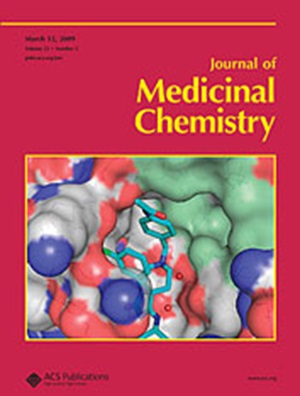口服KRAS G12D抑制剂INCB159020的发现
IF 6.8
1区 医学
Q1 CHEMISTRY, MEDICINAL
引用次数: 0
摘要
KRAS G12C抑制剂的临床成功证明,抑制突变的KRAS蛋白已成为治疗KRAS驱动的癌症的一种有希望的方法。KRAS G12D是最常见的突变体,有望显著扩大可治疗的患者群体;然而,与半胱氨酸相比,天冬氨酸的亲核性降低,在平衡足够的效力和ADME特性以支持口服暴露方面提出了重大挑战。在此,我们描述了KRAS G12D抑制剂23 (INCB159020)的发现,该抑制剂在非人灵长类动物(NHP)中实现口服暴露。从弱效的打击开始,基于结构的药物设计被用来驱动显著的效力。专注于分子刚性和平衡极性,然后允许口服暴露所需的性能成功优化。本文章由计算机程序翻译,如有差异,请以英文原文为准。

Discovery of INCB159020, an Orally Bioavailable KRAS G12D Inhibitor
The inhibition of mutant KRAS proteins has emerged as a promising approach for treating KRAS-driven cancers, as evidenced by the clinical success of KRAS G12C inhibitors. KRAS G12D, the most common mutant, promises significant expansion of the addressable patient population; however, the reduced nucleophilicity of aspartate compared to cysteine poses significant challenges in balancing sufficient potency with ADME properties to support oral exposure. Herein, we describe the discovery of KRAS G12D inhibitor 23 (INCB159020), which achieves oral exposure in nonhuman primate (NHP). Starting from a weakly potent hit, structure-based drug design was utilized to drive significant potency. Focus on molecular rigidity and balanced polarity then allowed for successful optimization of properties required for oral exposure.
求助全文
通过发布文献求助,成功后即可免费获取论文全文。
去求助
来源期刊

Journal of Medicinal Chemistry
医学-医药化学
CiteScore
4.00
自引率
11.00%
发文量
804
审稿时长
1.9 months
期刊介绍:
The Journal of Medicinal Chemistry is a prestigious biweekly peer-reviewed publication that focuses on the multifaceted field of medicinal chemistry. Since its inception in 1959 as the Journal of Medicinal and Pharmaceutical Chemistry, it has evolved to become a cornerstone in the dissemination of research findings related to the design, synthesis, and development of therapeutic agents.
The Journal of Medicinal Chemistry is recognized for its significant impact in the scientific community, as evidenced by its 2022 impact factor of 7.3. This metric reflects the journal's influence and the importance of its content in shaping the future of drug discovery and development. The journal serves as a vital resource for chemists, pharmacologists, and other researchers interested in the molecular mechanisms of drug action and the optimization of therapeutic compounds.
 求助内容:
求助内容: 应助结果提醒方式:
应助结果提醒方式:


